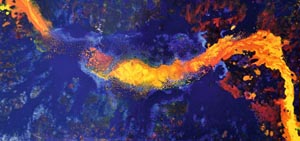David Sweatt, Ph.D., chair of the Department of Neurobiology in the University of Alabama at Birmingham (UAB) School of Medicine, is among the editors of the new textbook “Epigenetic Regulation in the Nervous System,” which was published by Academic Press today. He also illustrated the book with his paintings, which are inspired by epigenetics, the anatomy of nerve cells and the regulation of gene function in the brain.
 |
|
The fiery orange streak captures DNA methylation, an epigenetic mechanism regulating gene expression as the brain develops. When epigenetic mechanisms go awry, genes can be turned on or off in ways that lead to developmental brain disorders. The "break" in the streak represents an aberrant epigenetic change that has silenced the gene. |
The book addresses molecular, cellular, behavioral and clinical roles for epigenetic mechanisms in the nervous system. Epigenetic changes are chemical reactions that turn our genes on and off during our lifespan — without changing the DNA code we inherited from our parents. One theory has it that such reactions represent the mechanism by which our neural networks store memories.
“Given the recent rapid pace of discovery in this new scientific sub-discipline, it was time to introduce a foundational book that will be broadly relevant to emerging research programs investigating the role of epigenetics in the nervous system,” said Sweatt. “This book is the first unified synthesis of information on molecular epigenetics, development, cellular physiology and biochemistry, plasticity and behavioral models.”
The book is primarily intended for advanced undergraduates, graduate students, active researchers and physician-scientists newly interested in the emerging field. Interested parties can buy it at Amazon.com. Along with Sweatt, the book’s other editors were Michael Meaney, Eric Nestler and Schahram Akbarian.
Sweatt is also responsible for the book’s extensive illustrations, which are copies of his paintings depicting the role of epigenetic processes in the brain, and relate to work under way in his lab. As an artist, Sweatt’s paintings reflect a central theme, he said: “the awesome complexity of the nervous system at all levels, from cognition to molecular genetics to everything in between.”